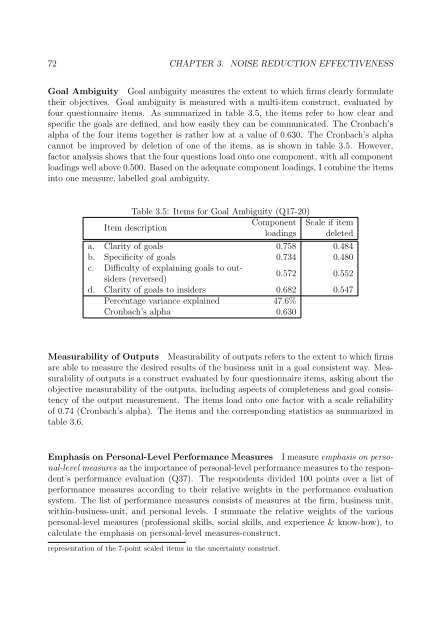pdf - Nyenrode Business Universiteit
pdf - Nyenrode Business Universiteit
pdf - Nyenrode Business Universiteit
You also want an ePaper? Increase the reach of your titles
YUMPU automatically turns print PDFs into web optimized ePapers that Google loves.
72 CHAPTER 3. NOISE REDUCTION EFFECTIVENESS<br />
Goal Ambiguity Goal ambiguity measures the extent to which firms clearly formulate<br />
their objectives. Goal ambiguity is measured with a multi-item construct, evaluated by<br />
four questionnaire items. As summarized in table 3.5, the items refer to how clear and<br />
specific the goals are defined, and how easily they can be communicated. The Cronbach’s<br />
alpha of the four items together is rather low at a value of 0.630. The Cronbach’s alpha<br />
cannot be improved by deletion of one of the items, as is shown in table 3.5. However,<br />
factor analysis shows that the four questions load onto one component, with all component<br />
loadings well above 0.500. Based on the adequate component loadings, I combine the items<br />
into one measure, labelled goal ambiguity.<br />
Table 3.5: Items for Goal Ambiguity (Q17-20)<br />
Item description<br />
Component<br />
loadings<br />
Scale if item<br />
deleted<br />
a. Clarity of goals 0.758 0.484<br />
b. Specificity of goals 0.734 0.480<br />
c. Difficulty of explaining goals to outsiders<br />
(reversed)<br />
0.572 0.552<br />
d. Clarity of goals to insiders 0.682 0.547<br />
Percentage variance explained 47.6%<br />
Cronbach’s alpha 0.630<br />
Measurability of Outputs Measurability of outputs refers to the extent to which firms<br />
are able to measure the desired results of the business unit in a goal consistent way. Measurability<br />
of outputs is a construct evaluated by four questionnaire items, asking about the<br />
objective measurability of the outputs, including aspects of completeness and goal consistency<br />
of the output measurement. The items load onto one factor with a scale reliability<br />
of 0.74 (Cronbach’s alpha). The items and the corresponding statistics as summarized in<br />
table 3.6.<br />
Emphasis on Personal-Level Performance Measures I measure emphasis on personal-level<br />
measures as the importance of personal-level performance measures to the respondent’s<br />
performance evaluation (Q37). The respondents divided 100 points over a list of<br />
performance measures according to their relative weights in the performance evaluation<br />
system. The list of performance measures consists of measures at the firm, business unit,<br />
within-business-unit, and personal levels. I summate the relative weights of the various<br />
personal-level measures (professional skills, social skills, and experience & know-how), to<br />
calculate the emphasis on personal-level measures-construct.<br />
representation of the 7-point scaled items in the uncertainty construct.
















